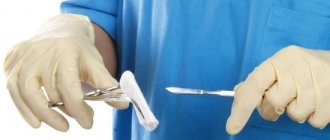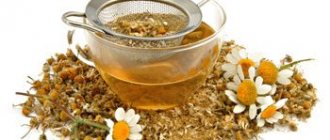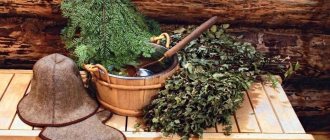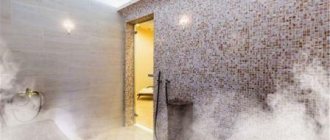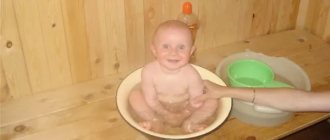Features of the course of furunculosis
Furunculosis is a disease of the hair follicles, in which a purulent-inflammatory formation, a boil, appears on the human body. Occurs due to the proliferation of staphylococcal infection. Bacteria enter damaged tissues from the external environment through household items. Chiri can form on:
The appearance of an internal boil is a painful process. A rapidly increasing subcutaneous compaction forms on the damaged area. The size of the abscess reaches several centimeters in diameter. When the boil matures, a purulent head appears in the center of the lump, through which the contents of the boil will come out. The process is accompanied by redness of the skin, swelling, and local hyperthermia. About 10 days pass from the appearance of the first signs to the start of the recovery period.
There are 3 stages of the disease:
- Infiltration.
- Purulent-necrotic.
- Healing.
Overview of General Recommendations
Boils, despite the apparent simplicity of the symptoms, are a dangerous formation. Boils often cause meningitis or sepsis. Due to non-compliance with the rules, a person endangers his own health and life. Carefully following the recommendations of doctors allows you to protect a person from the development of dangerous consequences.
Hygiene
The most important part of prevention and treatment is maintaining hygiene standards and proper care. A person who takes care of his own hygiene is rarely exposed to boils. Once an abscess has formed, keeping it clean is the key to successful and effective treatment.
After the appearance of boils, a person must stock up on individual household items. This includes towels, washcloths, clothing, combs, scissors, and razors. It is better to wash your body with your own soap; the risk of spreading an infectious pathogen is high. If the formation appears on a person’s face, it is important that the cosmetics remain personal.
Consider the need to regularly change underwear and bed linen, and wear clean clothes. Avoid tight synthetic items and give preference to lightweight natural fabrics.
Eliminate daily bathing if possible. If you wet a boil frequently, you can injure it. Water is a good spreader of infection. You can wash yourself by washing the abscess with warm water without unnecessary touching. You need to take a bath without cosmetic additives - salt, foam.
The issue of warming up is controversial. Some argue that this is an acceptable procedure, others are categorically against it. The relevance of warming up is determined by the stage at which the boil is located. You can heat a purulent boil at the stage of swelling and during the healing period. Dry heat, a common method, is effective in accelerating the maturation of the abscess and regeneration of the skin. Ultraviolet lamps are used. During the phase of filling with pus, heating the boil, much less steaming it, is strictly prohibited. Heat improves blood circulation, provoking the opening of a bladder with pus. The danger lies in the possibility that the boil can open inside, after which the infection spreads through the blood. Heat will intensify the symptoms - swelling will increase, pain will become severe.
Going to the sauna, swimming pool, or bathhouse with a boil is prohibited. They combine two undesirable factors - water and heat. If, under the influence of high temperature, the boil bursts (outward), the pus will spread, and the site of damage will become an “open gate” for bacteria to enter. It is better to avoid trips to the sea. Salt water “corrodes” the tissues of the abscess.
Physical activity
Physical activity is a necessary component for maintaining the health of the human body. When a boil appears on the body, the question arises about the relevance of sports.
If a person exercises regularly and systematically, it will be difficult to stop exercising. Classes are allowed in the first stage of furunculosis. As soon as the chiryak becomes full of pus, you should avoid physical activity. Associated with sweating, stretching of the skin due to movements, and a high risk of injury. If the boil bursts while playing sports, there is a risk of spreading the infection and introducing a new one into the open crater. In most cases, a person will not be able to play sports with a mature boil, as this will increase symptoms.
Having sex with furunculosis remains a sensitive issue. If an abscess has formed in the groin area or on the buttock, physical and emotional discomfort appears. A person cannot fully relax if purulent inflammation is in the intimate area. The process is accompanied by pain, which does not have the best effect on the quality of sex. As with sports, it is best to adhere to restrictions for the period from filling until the wound heals.
With furunculosis, doctors advise resting, staying warm, and eating well. At the infiltration stage, it is permissible to warm the boil with ichthyol ointment or Vishnevsky. Before using ointments, you should treat the skin around the abscess with a bandage, which should be moistened with antiseptic solutions. Do not use “colored” solutions, which may interfere with the assessment of the site of inflammation.

When is visiting a bathhouse beneficial?

Before answering the question of whether it is possible to take a steam bath when you have a cough, you need to find out exactly the reason for its occurrence. The healing properties of steam do not always have a positive effect, but in most cases, going to the bathhouse with a cough is not only possible, but even necessary.
The benefit of such procedures is that it is not just swimming; while in a steam room, the sick person inhales moist air saturated with essential oils, and in addition:
- Hot, moist air inhaled during a visit to the bathhouse has a special effect on the respiratory system. The mucus accumulated in them becomes softer, liquefies faster and is easier to remove.
- It is recommended to go to the bathhouse with a cough for those who suffer from an unproductive, obsessive, tearing cough.
- Treatment will go much faster, since under the influence of the high temperature of the inhaled air, the production of leukocytes that fight pathogens is activated.
- Hot steam penetrates the trachea and bronchi, moisturizes the nasopharyngeal mucosa, making breathing easier during dry coughs.
- A bathhouse built from any building material has a wooden interior. Heated wood releases many beneficial essential oils that help cure cough even in advanced forms of the disease.
All procedures in the steam room involve the use of a special bath broom, knitted from plant branches that have healing properties.
While in the steam room, all beneficial substances penetrate the patient’s body both through the respiratory tract and through the skin. In the deep layers of steamed skin, blood circulation is activated, under the influence of inhaled steam, the alveoli open, and the lungs are saturated with many useful microelements.
The compatibility of cough and bath has long been proven. A broom, hot steam, decoctions of medicinal plants, herbs that are present in the room and, when exposed to hot air and steam, release essential oils, have a highly beneficial effect on the general condition of a person, increasing the resistance of the body affected by the disease.
What events are strictly prohibited?
Furunculosis has enough restrictions regarding human behavior during the period of the disease. Doctors strictly prohibit:
- treat boils during the period of infiltration with coloring solutions - iodine, brilliant green, fucarcin;
- open, puncture ulcers;
- massage the area around the abscess;
- swimming in public places;
- wet a mature abscess;
- steam in baths, saunas;
- sunbathe in solariums;
- combine staying in the bathroom with children;
- treat abscesses with cosmetics;
- for eye furunculosis, use decorative cosmetics;
- independently select a treatment package;
- warm ripened boils;
- wear tight clothing if the abscess is located on the legs or groin;
- apply wet compresses;
- use tight bandages.
The main rule that dermatologists call for is that you should not try to open a boil yourself. This will lead to the spread of staphylococcal infection through the tissues, the formation of new foci of purulent inflammation or damage to internal organs and death of the patient.
People with purulent formations are advised to avoid heavy physical labor, work in contaminated premises, and on land. It is advisable to limit contact with animals and sources of bacteria.
Recommendations of an immunologist for furunculosis
Formations on the skin are closely related to a decrease in the protective function of the immune system. Maintaining immunity is a key link in disease prevention. A balanced diet, a moderately active lifestyle, and the absence of bad habits have a beneficial effect on the immune system and the condition of the skin. You need to remember about the local immune protection of the skin. Following the rules of hygiene will prevent the appearance of boils.
Do not delay the treatment of purulent abscesses. Natural defenses cannot independently resist infection. It is important to support her with appropriate medications. Do this solely on the basis of a diagnostic examination and consultation with an immunologist, dermatologist and infectious disease specialist. Modern immunology strongly recommends that patients with furunculosis consult a doctor at the first symptoms of illness.
Furunculosis is a disease in which it is important to take a responsible approach to the treatment process. In order not to harm the body, it is advisable to consult a doctor before starting a health activity. An experienced specialist can advise effective methods of therapy.
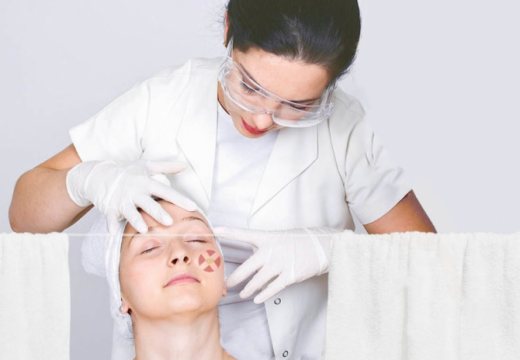
Recommendations for furunculosis are needed to reduce the frequency of relapses. It is important to follow doctors' instructions and limit exposure to high and low temperatures on the formation, mechanical friction and contact with the wound.
Treatment of rhinitis in the bath
In order for the treatment of rhinitis in the bath to be as effective as possible, each person should adhere to certain rules. Before going to the bathhouse, it should be thoroughly warmed up. This can be done by pouring a ladle of water onto the hot stones to create steam. The patient should sit in such an atmosphere for 15 minutes. This time is enough for the body to warm up, and sweat will begin to be actively released, which can be enhanced by using a broom.
If a person has a runny nose, then to eliminate this problem, a solution of some essential oils, for example, eucalyptus, mint, etc., must be poured onto the stones in the steam room. They have a beneficial effect on the patient’s entire body.
A very useful remedy for rhinitis are decoctions of medicinal herbs prepared according to folk recipes. In this way, you can prepare a mustard decoction, pour it on the stones and inhale the vapors.
In order to enhance the effect of going to a steam bath, it is better to take with you prepared tea from herbs that have a beneficial effect on the nasopharynx. The list of such remedies includes buckwheat flowers, tricolor violet, poplar buds, etc.
Thus, the bath can be called an excellent remedy against rhinitis and colds. Therefore, if there are no contraindications, then you can go to the steam room for treatment with all the courage and complete confidence.
Lifestyle with furunculosis: recommendations of immunologists
The course of furunculosis is influenced by many factors. According to the recommendations of immunologists, in everyday life you need to follow the following advice:
- complete, balanced diet, rich in vitamins, plant foods, proteins;
- It is recommended to maintain an active lifestyle;
- giving up bad habits;
- avoid overheating or hypothermia;
- keep the body clean;
- regularly sanitize foci of chronic infection.
- mode of work and rest.
In severe cases of furunculosis, it is recommended to correct the immune system with the help of medications. After immunotherapy, long-term remission of the disease can be achieved.
Avoid drying and damaging the scalp, groin and thighs. It is recommended to maintain good personal hygiene.
When new boils appear, it is recommended to seek help from a specialist; conservative treatment is effective in the first stage of maturation.
How to speed up the ripening of boils
The faster the boil matures, the sooner the purulent contents will come out and the process of skin regeneration will begin. You can speed up the maturation of boils using a number of medications and folk remedies.
It is best to ask your doctor what to do to make the boil ripen faster. To speed up this process, the following ointments are usually prescribed:
- ichthyol;
- synthomycin;
- hyparin.
A universal remedy is ichthyol ointment. This drug contains healing resins and sulfur, due to which it has an antiseptic and astringent effect.
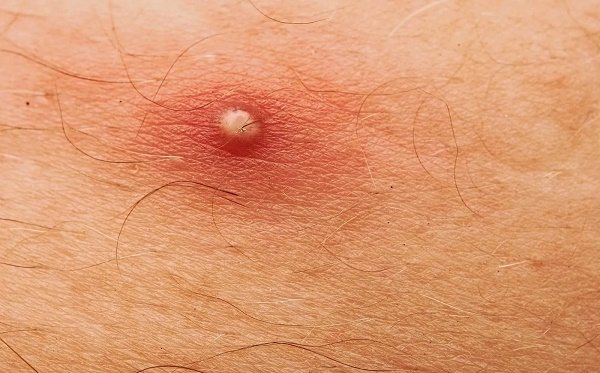
As a rule, glycerin and petroleum jelly are used as auxiliary components of the drug, which ensures softening of the skin. The ointment is very effective at the early stage of abscess development. It significantly speeds up this process, promoting the rapid accumulation of pus and the bursting of the boil. Thanks to the sulfur in the composition, an analgesic effect is provided. The emollient components of the product have a beneficial effect on the skin, as a result, the breaking of the boil is painless.
This ointment is applied to the inflamed area under a compress. The frequency of treatment of the abscess depends on its size and stage of maturation. As a rule, the ointment is applied twice a day.
Heparin cream or ointment also has antiseptic and emollient properties. This remedy actively fights bacteria and is well absorbed into the blood due to its vasodilating effect. The drug is applied either directly to the boil or under a gauze compress. The frequency of skin treatment and treatment regimen are selected individually by the doctor. The main property of this medicine is its analgesic and anti-inflammatory effect, due to which discomfort is reduced after the first application of the ointment to the boil. Heparin ointment can be used at any stage of boil maturation.
Water procedures for chiria
The body has a water-lipid membrane, which performs a protective function against microbes and the external environment. Violation of its integrity contributes to the development of a purulent-inflammatory disease - furunculosis. You can swim without harm once every two days. But each person has their own skin characteristics, the norm is individual. If you have furunculosis, you can swim, but you cannot wet the boil.
Taking a bath
According to the recommendations, the bath should be taken so as not to wet the boil with water. This is often difficult to do.
The water temperature should not exceed 40 degrees; the inflamed area should not be heated. Furunculosis is an acute inflammatory process. According to doctors' recommendations, local heat is contraindicated in this case. When the disease occurs, the body's resistance to Staphylococcus aureus is reduced, entering the thickness of the epidermis and causing growths to appear. In places where the integrity of the epidermis is compromised, the microorganism invades and begins to multiply, leading to the appearance of new lesions.
During remission of furunculosis, you can wash, but it is better in the shower. Visiting the pool is allowed, but in the absence of purulent foci. The water in the pool is chlorinated, which has a bactericidal and drying effect.
During the period of remission, when there are no foci of acute inflammation, it is recommended to undergo sanatorium treatment. The best means for preventing furunculosis are radon and hydrogen sulfide baths. They have general strengthening and bactericidal effects. Helps restore skin barrier function.
Effective herbs for furunculosis:
- celandine;
- series;
- walnut bark and leaves;
- lungwort;
- chamomile;
- calendula.
To prepare a bath with chamomile infusion, it is recommended to take 0.5 kg of flowers, add 8 liters of water, and boil for 10-15 minutes. Let it brew for an hour or two. Then pour the broth into the bath. The temperature should be 36-38 degrees. Bathing in such a bath will improve the condition of your skin. Chamomile has bactericidal and anti-inflammatory properties.
A bath with a series for furunculosis is done in the same way. It is recommended to take 100 g of plant material and boil for 10-15 minutes in 10 liters of water or pour boiling water in the same amount and let it brew for an hour. Add 100 g of salt for better effect. Water temperature 37-38 degrees.
The roots of the celandine are crushed and filled with water, then brought to a boil and boiled for 20 minutes. Then decant and add to the bath. To achieve maximum effect, a course of treatment of furunculosis of 8-12 baths is recommended.
Decoctions of other herbs are prepared similarly. It is recommended to consult a doctor before using medicinal baths.
Swimming in the sea
The high salt content in sea water has a beneficial effect on the condition of the skin, but swimming in the sea is not recommended for furunculosis. The temperature factor (overheating in the sun, cold sea water) and acclimatization have a negative effect.
Getting the body used to new environmental conditions negatively affects the immune system. In a hot climate, the water-electrolyte balance is disrupted, the work of the sweat and sebaceous glands increases, and metabolic processes change. This affects the body's resistance to infectious agents. Excessive sweating affects the proliferation of microorganisms; exacerbation of furunculosis for this reason is observed in the summer. It is recommended to avoid trips to the sea if remissions are unstable.
Going to the bathhouse
It is contraindicated to go to a bathhouse or sauna with a boil. Boils are characterized by acute inflammation, in which the use of heat is contraindicated. It causes the spread of the process, increased exudation, swelling, dilation of blood vessels in the area of inflammation, which can lead to staphylococcus entering the blood and the development of complications. You can heat a boil during the recovery period, heat promotes healing, it is recommended by doctors
When visiting a bathhouse is contraindicated
Is it possible for a child to go to the bathhouse with a cough? This question will be answered by a doctor who will accurately determine the cause of the cough and be able to rule out the presence of an allergic reaction to the herbs and medicinal plants used during the procedure.
Before deciding to go to the bathhouse with a sick child, you should definitely consult with a pediatrician.
The attending physician will explain to parents that steam, which is so useful and effective in treating colds, can cause harm if there are concomitant diseases in the medical history:
- changes in blood or intracranial pressure;
- cerebrovascular accidents;
- increased body temperature;
- epilepsy;
- whooping cough;
- tuberculosis.
An absolute contraindication to visiting the bathhouse is malignant neoplasms. A bath is contraindicated for coughing in a child or in an adult in cases where there is a negative reaction directly to the hot steam itself.
As for elevated temperature, its value above 37.2˚ is already a direct contraindication for visiting the bathhouse. Under the influence of hot air, the temperature will only increase, and the patient’s condition will rapidly worsen. Parents who are planning to go to the bathhouse with coughing children should make sure that this is a manifestation of a cold. A slight cough may be a symptom of one of the heart diseases, and in this case, going to the bathhouse while coughing is strictly prohibited. Both an adult and a child with a cough can go to the bathhouse if they have ARVI, acute respiratory infections, bronchitis, or laryngitis. But only the attending physician can give appropriate recommendations.
Features of physical activity with a boil
Physical activity is necessary to maintain immunity. With furunculosis in remission, moderate exercise training increases resistance to staphylococcal infection. Do not overload the body with strength exercises. After grueling training, the body needs time to recover; it is not able to fight the infection that has arisen. It is fraught with the appearance of new formations; during training, sweating increases, which is a predisposing factor.
Sport
According to doctors’ recommendations, you can play sports with a boil during the remission stage, but maintain personal hygiene. After training, take a shower to wash off sweat, which is a favorable environment for the growth of bacteria. Thoroughly wash the places where it accumulates: armpits, groin, between the buttocks, under the breasts, in skin folds.
When furunculosis worsens, physical activity should be limited. Working with machines or free weights can cause damage to a ripening boil. As a result, the formation will open or increase in size. The latter can lead to abscess formation of the process. Exhaustion of the body by exercise reduces the body's defenses, which aggravates the course of the pathology.
It is not recommended to actively train when the boil passes into the purulent-necrotic stage.
Sexual relations
It is not recommended to have sex with furunculosis if a boil appears in the groin or on the butt. In these areas, there is a high chance of damage to the formation - it can cause a breakthrough of the abscess or a complication of the disease. A purulent focus is a source of infection.
During remission, you can make love, but do not forget that any skin injury can become a provoking factor.
What not to do with furunculosis
Actions that are prohibited during furunculosis:
- home autopsy of growths on the face, which is fraught with the development of meningitis or blood poisoning;
- swimming in stagnant bodies of water or rivers is not recommended by doctors;
- wet the abscess when a purulent-necrotic core appears;
- steam the sore spot;
- sunbathing, going to the solarium;
- apply cosmetics to the surface of the boil;
- warm up the abscess;
- tightly bandage the source of inflammation;
- self-medicate;
- squeeze out the immature boil with your fingers;
- located in hot, dusty rooms;
- self-administration of antibiotics;
- engage in heavy physical activity;
- do not follow the doctor's recommendations.
Failure to follow the recommendations leads to a complicated course of the disease, the spread of staphylococcal infection, frequent relapses and prolonged healing.
A furuncle (popularly boil) is a tubercle on the scalp of the skin, inside of which pus accumulates. Appears due to the entry of white or golden staphylococci into the hair follicle. Treatment of boils or furunculosis is not recommended at home. Squeezing or heating a chir, especially on the face, can end in disaster.
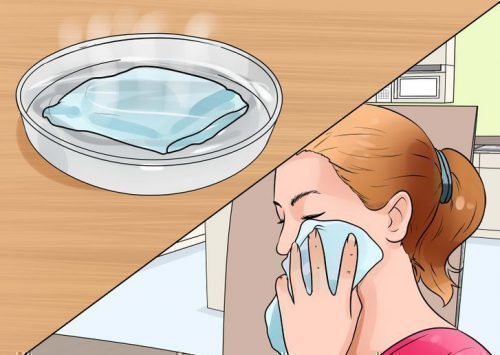
Heating a boil can have unpleasant consequences
Furuncle - causes, symptoms and treatment of boils, Medicine on - Good IS!
Good day, dear readers!
Today we will look at such an unpleasant phenomenon on the skin as a boil, as well as everything connected with them. So…
Furuncle (boil) is a pustular skin disease characterized by acute purulent-necrotic inflammation of the hair follicle and surrounding connective tissue.
The main cause of a boil is a bacterial infection, mainly Staphylococcus aureus, less often white.
Furunculosis is a massive, repeated, chronic formation of boils.
The place where the boil appears can be anywhere except the soles of the feet and palms, but most often, boils form on the back of the head, forearms, lower back, buttocks, abdomen, and lower extremities. The most painful boils are in the ear, nose, face and genitals.
The prognosis for a boil is positive, but there are still complications with this disease - thrombosis, lymphadenitis, sepsis, due to which the formation of boils is considered a fairly serious disease.
Boils have a certain seasonality - most often they form in autumn and spring. In addition, doctors note that most often, boils appear in men, but in children this is generally rare.
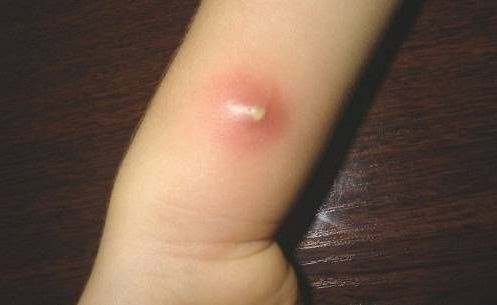
The development of a boil can occur primarily - on healthy skin and secondary, when development occurs against the background of other pathological conditions and diseases of the body, for example, staphyloderma.
Furuncle stage 1 (beginning) - characterized by inflammation of the follicle, in which a solid infiltrate (compaction) of bright red color with unclear boundaries appears in a given place. At the site of the inflamed follicle, pain and tingling are felt. As the boil grows, the seal increases in size, expands, and the surrounding tissues swell.
Stage 2 boil (3-4 days) – characterized by expansion of the boil up to 3 cm in diameter, while in the center of the compaction a purulent-necrotic core with a pustule on the surface is formed. Not only the hair follicle is involved in the process of suppuration, but also the sweat gland with the surrounding connective tissue, while the vessels around it dilate and swelling of collagen is observed.
The shape of the boil begins to take on a cone-shaped shape, as if it were a growing mountain. Inside the “mountain”, elastic and collagen fibers are destroyed. Collagenized bundles of fibers form a thick protective ring inside the boil, preventing the infectious purulent formation from exiting into the body and its further infection, so it is very important not to squeeze out the boil without understanding the consequences of this process. The opening of the boil must be correct.
Further, the skin at the site of inflammation becomes smooth, bluish in color, and the pain intensifies. In case of extensive damage to the body by infection (in the case of a large number of boils), a person may experience symptoms of intoxication, which are expressed by general malaise, weakness, nausea, lack of appetite, headaches and an increase in body temperature up to 38 ° C.
Stage 2 of boil development ends with the spontaneous or artificial opening of the pustule and the release of its contents. The contents of the pustule are a necrotic rod of yellow-green color with a purulent formation, sometimes with the addition of blood.
Stage 3 boil – characterized by the appearance of a “crater” at the site of the opening of the abscess, which is initially filled with granulations, and after 2-3 days, scarring occurs in this place. The scar at the beginning of healing is red, but as it heals it turns white and becomes almost invisible.
The entire flow cycle may be erased; for example, the entire process sometimes occurs only with the formation of infiltrate, i.e. without pus and necrosis. In other cases, the boil, against the background of weakened immunity and other diseases, acquires an abscess or phlegmonous form.
ICD-10: L02; ICD-9: 680.9.
The main cause of a boil is a bacterial infection, mainly Staphylococcus aureus, less often white.
This infection is present on the surface of the skin of almost every person, but due to strong immunity, the normal functioning of all other organs and systems, as well as the absence of violations of the integrity of the skin, staphylococcus does not harm health in any way. By the way, a weakened immune system is one of the main reasons for the development of many infectious diseases.
A boil develops when two conditions are combined - the presence of an infection and a pathological factor, which can be external (exogenous) or internal (endogenous).
- Skin contamination;
- Skin trauma - microtraumas, cracks, cuts (especially when shaving), scratching with nails, rubbing the skin with uncomfortable clothes or shoes;
- Poor quality food;
- Hypothermia or overheating of the body;
- Constant stress.
- Reduced immunity;
- Increased sweating and sebum secretion;
- Violation of metabolic processes - metabolism;
- Alcohol abuse, smoking;
- The presence of diseases such as staphyloderma, eczema, anemia, diabetes mellitus, hypovitaminosis, obesity, acute respiratory infections, as well as other diseases of the gastrointestinal tract, endocrine and nervous systems, infectious etiology.
- An acute boil is a classic development of a boil;
- Chronic boil (furunculosis) - characterized by a large number of boils at different stages of development, over a long period of time.
- Primary – development occurs when the integrity of the skin is violated and infection penetrates into this area.
- Secondary - development occurs against the background of existing skin diseases - eczema, staphyloderma and others.
- Visual inspection;
- Anamnesis;
- Dermatoscopy;
- Bacterial inoculation of the contents of the boil.
- General blood analysis;
- General urine analysis;
- Urine culture;
- Pharyngoscopy;
- Rhinoscopy;
- X-ray of the sinuses;
- Fluorography;
- Computed tomography (CT);
- Magnetic resonance imaging (MRI) of the brain.
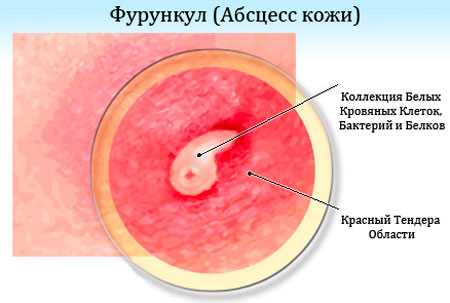
The main symptom of a boil is the formation of a red compaction (infiltrate) in the area of the inflamed follicle, up to 3 cm in diameter, on the surface of which a pustule forms over time. Inside the boil there is a purulent-necrotic core and a purulent formation, sometimes mixed with blood. In some cases, the boil is treated only by the formation of a reddened infiltrate.
Other symptoms of a boil include pain and a tingling sensation in the inflamed area, as well as swelling of the surrounding tissues.
Against the background of weakened immunity and the spread of infection within the body, general malaise, increased fatigue, drowsiness, loss of appetite, nausea, increased body temperature to 38 ° C and headache may be observed.
After the necrotic tissue is rejected, healing occurs through scarring. Most often, boils occur on the skin of the neck, back of the head, face, back, and thighs. The appearance of boils at different stages of development is called furunculosis, and purulent-necrotic inflammation of the skin and subcutaneous tissue around a group of hair follicles and sebaceous glands is called a carbuncle. If a boil is found on the face, serious complications are possible (purulent meningitis, sepsis).
The classification of a boil is as follows...
How to treat a boil? Treatment of a boil primarily depends on the stage of the inflammatory process.
At the first stage of the boil (infiltration period), ultraviolet irradiation is used.
At the second stage (maturation period), a blockade is placed to relieve the infection and relieve pain - the boil is injected around the circumference with solutions of antibacterial drugs and novocaine. Injections are carried out in the surgical department.
We suggest you familiarize yourself with When Indian ducks start laying eggs at home
The antibiotic is selected based on diagnosis and resistance (resistance) to the infection.
Among the most used antibiotics for the treatment of boils are: Amoxicillin, Methicillin, Oxacillin, Cephalexin, Erythromycin.
Along with antibacterial therapy, sulfonamides are often prescribed.
To avoid allergic processes in the body from the use of antibiotics, antihistamines are used: Diphenhydramine, Pipolfen, Suprastin.
The effectiveness of the blockade in the “classical” course of the boil is characterized by rapid recovery. In other cases, it leads to a more rapid course of the disease - activation of the inflammatory process, its delimitation and rapid healing.
To prevent damage to the inflamed area, which causes pain and the risk of rupture of the internal protective “ring” in which the purulent contents are located, a removable plaster splint is applied to the boil.
If the blockade is ineffective and the inflammatory process with pain intensifies, it is repeated every other day or every day until the boil opens and the purulent-necrotic core comes out. In this case, a bandage with a 1% solution of silver nitrate is applied to the inflamed area, which must be changed daily.
Ichthyol is an effective remedy for pain relief, disinfection and relief of inflammation. A hair is removed from the center of the boil, after which a thick layer of “Ichthyol ointment” is applied to the boil, onto which loosened cotton wool must be applied. When dry, cotton wool forms a so-called “ichthyol cake”, which is easily washed off with warm water.
After opening the boil, its cavity is washed with a 3% solution of hydrogen peroxide and bandages are applied with a hypertonic solution of sodium chloride, which is intended to cleanse it of necrotic masses. The purulent-necrotic core of the boil can be removed only after it is completely separated from the surrounding tissues.
Important! Under no circumstances should you open a boil by squeezing, since there is a high probability of breaking the internal protective ring, after which the infection can spread throughout the body causing a number of serious and life-threatening complications!
At the third stage (healing period), after extracting the contents of the boil, the skin around the boil is treated with alcohol, brilliant green (diamond green) or methylene blue.
Furunculosis and boils
Furunculosis has a scientific name that reflects the essence of the disease - it is staphyloderma. It is characterized by the appearance of multiple boils on the skin. They can be localized in one place or dispersed throughout the body. You can't joke with a boil. Single boils often appear on the back of the neck, back of the head, back (especially on the shoulder blades), shoulders, armpits, arms and legs. Boils are widespread on the face, in the area of the nasolabial triangle. These parts of the body have developed hair and sebaceous glands are actively working.
There is only one reason for the development of a boil - bacteria, most often staphylococci, enter and multiply in the area of the hair follicle.
How does the inflammatory process develop?
- The forces of the immune system rush to the site of infection, and leukocytes and macrophages penetrate there. These are special cells that eat foreign microorganisms.
- The inflammatory process begins.
- A hollow tubercle appears on the skin. It is red in color, and the skin around the boil is also red.
- Gradually, the top of the boil becomes white. This indicates that pus is accumulating inside the cavity. Pus is a cloudy liquid substance consisting of “dead” white blood cells and killed microorganisms.
- The inflammation ends with the opening of a mature boil and the release of pus. Boils need to be opened surgically, without waiting for an abscess.
Treatment of furunculosis and single boils is carried out strictly under the supervision of a doctor.
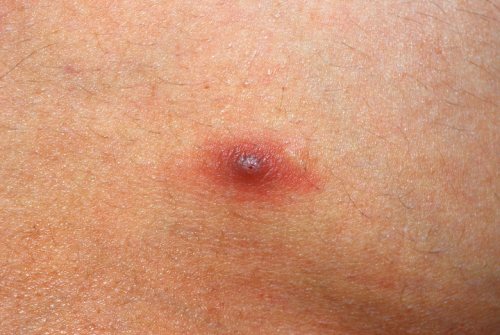
The boil is red in color with a white tip
What is a boil and how to treat it
Our skin serves as a reliable protector from external irritants and dangers. The skin usually performs its functions well. We must help it retain its properties for as long as possible. In order to keep your skin healthy and clean, you need to use various skin care products. Without doing this, we ourselves weaken the protective properties of the skin; it will take more time to restore its functions. She may even get sick, and her illness manifests itself in the appearance of pimples, age spots, and boils. Some problems (acne and age spots) can be solved quite simply on your own, but with a boil the situation is more complicated.
What is a boil
Let's first find out what kind of disease this is - a boil. A boil, or boil, is an inflammatory process on the skin in which cavities in the skin are filled with pus.
In medicine, a boil is an inflammatory process that involves the sebaceous gland, hair follicle and nearby connective tissue. The cause of a boil is a pyogenic bacterium. Most often, the appearance of a boil is caused by Staphylococcus aureus.
The size of boils can vary from a few millimeters to six or more centimeters.
This kind of inflammation can appear on any part of the body, but there are places where it appears more often. Favorite places for boils are the neck and armpits. It is possible to detect a boil in the face, buttocks, chest, or groin area.
If several boils are located close to each other or the abscess is large, then it is called a carbuncle. The difference from a simple boil is the deeper location and painfulness of the formation.
If skin rashes are located in different places on the body, and they represent communities of boils of varying degrees of maturity, then this disease is called furunculosis. Furunculosis can appear in a person of any age.
Medicine even knows a type of furunculosis, in which a small area on the skin becomes covered with boils in large numbers. This type of disease is called local. It cannot be treated on its own, so you must definitely go to your doctor.
Doctors also distinguish the course of furunculosis in acute and chronic forms. Acute furunculosis is characterized by the formation of a large number of boils in a short period of time. The course of the chronic form is characterized by the alternation of the appearance of individual ulcers, or periodic outbreaks of the disease.
The main thing that needs to be done immediately when a boil is detected on the skin is to contact a medical facility. Only a doctor with experience in treating such formations will recommend a course of treatment that will bring the greatest effect and take into account the peculiarities of the development of the disease.
Causes of boils
The most common cause of a boil is bacteria entering the hair follicle. This is the most common reason, but it is not the only reason that can cause a boil. The causes of the appearance of ulcers can be skin trauma (even the smallest, unnoticeable one), increased secretion of sweat, subcutaneous sebum, and untimely cleansing of the skin. Health disorders such as impaired metabolism and reduced immunity can trigger the appearance of ulcers. Eating unnatural foods with dyes and carcinogens also does not add health.
A boil usually manifests as pain at the site of its occurrence. It is often accompanied by severe and annoying itching and slight swelling.
What to do if a boil appears in the ear?
A boil that appears on any area of the body is dangerous to humans. The most dangerous are ulcers located on the head. A boil located on the auricle, especially inside it, will bring a lot of unpleasant sensations. In this case, the usual symptoms may be accompanied by deterioration of hearing, or even temporary loss of hearing, tinnitus. When talking or chewing food, pain in the lower jaw may occur. What to do to get rid of these unpleasant consequences and the boil itself?
The first step is to consult your doctor. Self-treatment can end badly and leave a lot of unpleasant consequences. Only a specialist will tell you how to most safely and reliably get rid of both pain and boils. You should not self-medicate; trust your health to your doctor.
If a boil has formed in the armpit
The appearance of a boil in the armpit is accompanied by redness and swelling of the skin. Movement of the hand becomes difficult and painful. The appearance of a boil under the arm can be favored by excessive sunbathing, insufficient personal hygiene, and increased sweating. How to cure a boil located in the armpit on your own?
What you definitely cannot do yourself is remove the tumor.
Removing a boil only solves the problem of its existence on the body, but the cause of its appearance must be found out, and only then can we talk about getting rid of such a disease forever. Treatment of the boil should begin immediately. A doctor will help determine the cause of boils. He will prescribe an examination that will show the presence or absence of bacterial infection. If such an infection is present, antibiotics are prescribed internally and externally in the form of an ointment with an antibacterial effect. Other causes can be removed by adjusting the diet: sweet, refined foods are prohibited, and too fatty foods should be avoided.
The problem of boils in diabetic patients
Diabetes is a very common disease today. Age is not an obstacle for him. A variety of diseases accompany a disease such as diabetes. The occurrence of ulcers is especially common in diabetics. The frequency of their occurrence is much higher than in healthy people. What is this connected with?
The main reason for this “stickiness” of boils is a decrease in the body’s resistance in diabetic patients. A malfunction in the functioning of the entire body is caused by a lack of insulin.
In such cases, it is absolutely impossible to fight boils on your own. Consultation with an endocrinologist is mandatory. Only a specialist can make the correct diagnosis. Otherwise, a single boil can develop into a more serious form of carbuncle or furunculosis.
Only comprehensive treatment of boils or furunculosis in diabetic patients can ensure a complete cure. Glycemia levels should be reduced only after the amount of insulin in the body has stabilized.
What can be done to make the boil ripen quickly?
Scientists have long established that the entire disease process lasts a very long time. The head of the boil may appear after at least 3 days. All this time, the unpleasant pain will constantly remind you of the problem that has arisen. Therefore, many people wonder: is it possible to speed up this process and reduce pain?
The answer to this can be some folk methods that have long been used in such cases:
- You need to take a small aloe leaf and cut it into two identical parts. Both pieces are fixed on the surface of the skin above the formation. In this case, the following property of the healing plant will be indispensable: it pulls pus out, which contributes to the accelerated appearance of the boil. After the boil has completely ripened, aloe helps to heal the resulting wound.
- If there is no aloe, then another remedy can come to the rescue. It is a special soap and onion paste that helps treat unwanted ulcers. To prepare the product, bake the onion and pass it through a meat grinder. Rubbed laundry soap is added to the finished pulp. This mixture is quite easy to prepare. It can be used as a compress, changing the bandage at least 2 times a day.
Is it possible to wet a boil and go to the bathhouse with it?
Many experts argue about this. Most often, dermatologists prohibit the patient from soaking the formation and the wound that forms after the boil has matured. You shouldn't go to the bathhouse. It is contraindicated for this type of skin disease, because water and steam procedures can not only slow down treatment, but also complicate the healing process.
Only in one case can a real specialist advise a person to go to the doctor: if he is suffering from a chronic form of the disease, but the formations on the skin cannot be classified as inflammatory-purulent.
Traditional medicine treats boils a little differently. Many people claim that after a bath, unpleasant ulcers disappear within a few days.
But it is best to sensibly assess your strengths and choose the treatment method that seems most effective.
When does surgery occur?
If the usual treatment for this skin disease does not give any comforting results, then doctors can resort to a surgical method, which is quite rare (most often in the case of an abscess).
A person can only be operated on under local anesthesia. An autopsy can also occur under general anesthesia, but this is only possible when the disease is in an advanced state. To remove all the pus and the core of the formation, an incision must be made above it. After cleaning the wound and treating it, the area must be bandaged. This method of treating the disease is quite effective, because the likelihood of relapse is very small, and the unpleasant pain, which could greatly wear down a person’s strength, disappears instantly.
Blood cleansing
The most dangerous place where the appearance of unpleasant formations is undesirable is the nasolabial triangle. The development of boils in this place is most intense, so untimely treatment can cause blood poisoning, which will lead to a quick and unpleasant death. Therefore, in cases where the problem has become serious, blood cleansing may be prescribed. If you are not offered to do this procedure, then your condition is relatively stable.
There are a large number of methods that are used to cleanse the blood. All of them are aimed at combating dangerous bacteria of the staphylococcal group, because they are the causative agents of this disease.
pryshchamnet.ru
Causes of skin infection
Staphylococci, fungi and other microorganisms live on the skin and sebaceous glands of any healthy person. Normally they do no harm. Under certain conditions, bacteria begin to actively multiply and affect different layers of the skin, causing inflammation.
Factors contributing to the appearance of boils:
- Contaminated skin. Failure to comply with hygiene rules favors the proliferation of staphylococci.
- Constant rubbing of the skin by clothing. This is typical for the neck and armpit area. Tight clothing injures the skin, compromising its protective properties. Staphylococci get inside, and inflammation begins.
- Skin contact with chemicals. Chemical burns damage the skin and promote infection.
- Mechanical damage to the skin - cuts, abrasions.
- Weakening of the immune system. The body does not fight the pathogenic microflora of the skin, the infection develops and penetrates deeper. Immunity is reduced due to colds, diabetes, chronic alcoholism, and stress.
Improper treatment of a boil - squeezing and opening at home - can cause blood poisoning. A squeezed boil on the face can cause meningitis, an inflammation of the brain. The face shares blood flow with the brain.

Staphylococci multiply quickly in poor hygiene conditions
What is prohibited when treating a boil
Boils seem to be commonplace to some; they are treated with traditional methods without discerning what is useful and what is harmful. Few people know whether it is possible to go to the bathhouse with a boil, wet it with water or warm it.
When a boil appears, it is strictly prohibited:
- Treat the sore spot with brilliant green, iodine or fucorcin. Dying substances will prevent the doctor from determining the exact amount of suppuration and the depth of inflammation.
- Squeeze out boils with your fingers and nails. By applying incorrect pressure, you can inject pus into the skin layers and into the bloodstream. This can cause an abscess. Squeezing boils on the face leads to the development of inflammation in the brain, which can result in death.
- Open ulcers with sharp improvised objects, even if they have been treated with an antiseptic. Household treatment will not completely disinfect the item, which will lead to additional infection.
- Take antibiotics on your own. Antibiotics are one of the components of the treatment of boils. But you can take them only after a doctor’s prescription and under his supervision.
- Apply non-sterile bandages to the opened abscess.
- Steam in the sauna and take a hot bath.
- Warm boils on your face with a blue lamp.
- Wet the opened boil with water.
Compliance with these recommendations will make the doctor’s work easier and help avoid complications and undesirable consequences.
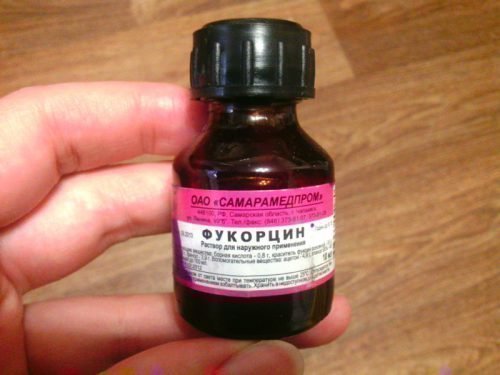
Fukortsin is not used to treat boils
Is it possible to go to the bathhouse when you cough?
Visiting the bathhouse is a common folk method for treating isolated ENT and respiratory tract diseases. In addition, periodic bath procedures effectively increase local immunity and help cure chronic respiratory disorders. That is why it is useful to go to the bathhouse when you cough.
A wet Russian bath will help with a dry cough, and a Finnish one will help with a wet cough.
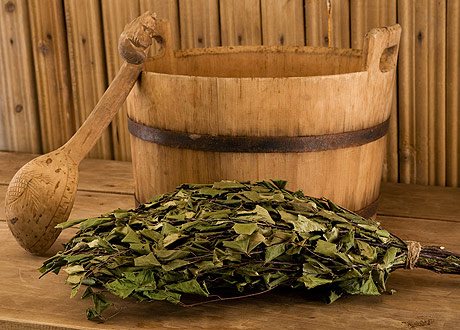
The bath regime for coughs is useful for the following reasons:
- Acting like inhalation, hot air expands the bronchi and makes breathing easier, reducing the number of deep coughing attacks.
- Massage movements with a broom in the sternum area also help open the bronchi and relieve dry and wet coughs. It is worth remembering that movements in this area should be gentle, since the cardiac area is affected.
- Increased air humidity in the form of steam contributes to the effective removal of sputum during a wet cough.
- In addition, the humidity in the steam room can speed up the process of turning a strong dry cough into a wet one and reduce the pain caused by a dry throat and larynx.
- An increase in body temperature in the steam room is followed by the manifestation of the human body’s protective mechanism - the production of leukocytes, which are blockers of viruses and pathogenic microorganisms.
- Profuse sweating, due to uniform heating of the entire body, removes pathogenic bacteria and toxins from the body.
- Increased blood circulation and muscle relaxation, achieved through high air temperature and the use of a broom, relieve weakness in the body.
- A visit to the steam room allows you to stabilize the nervous tension that accompanies the patient. If a person continues to cough for a long time, the nature of the symptoms becomes debilitating and painful for the emotional background.
Thus, visiting a bathhouse can have a beneficial effect on the body and cure a cough with:
- acute respiratory infections;
- ARVI;
- asthma;
- bronchitis;
- laryngitis;
- chronic tonsillitis in remission.
Going to the bathhouse with a cough is useful, especially if various medicinal herbs are additionally used in the steam room - the so-called steaming.
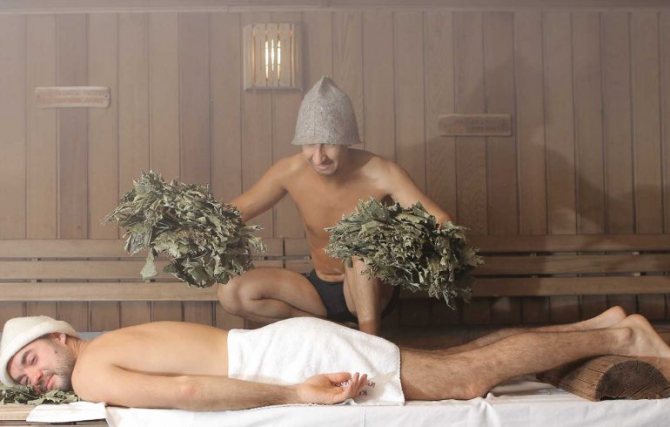
With the help of plants such as birch, linden, eucalyptus, sage, the healing effect of aromatherapy is created. To relieve a patient from a cough, you need to place the selected herbs in a container, and then from time to time pour hot water over them to enrich the air with their beneficial properties (phytoncidal, antiseptic, softening). Thus, while in the steam room, a person inhales beneficial fumes.
The list of medicinal herbs that help get rid of cough includes:
- chamomile;
- thyme;
- Linden;
- birch;
- juniper;
- eucalyptus;
- Melissa;
- sage;
- calendula;
- nettle.
Despite the positive effect of bath procedures in the presence of a cough, the patient should take into account precautions. This need is due to the ambiguous influence of temperature contrast on the human body. Restrictions on its use may be associated with the following circumstances:
- The peak of the current ENT and bronchial diseases is observed. Treatment of cough in a bathhouse is effective and permissible only at the beginning of the disease (on the first or second day) or after it ends and when the cough becomes chronic. It is strictly forbidden to visit the bathhouse at a high body temperature and in the midst of an infectious lesion, since such a method of treatment will only aggravate the patient’s condition. Even ordinary inhalation warming is unacceptable at high body temperatures. At the same time, the framework is quite strict: visiting the bathhouse is possible at a temperature no higher than 37 degrees (depending on individual characteristics, a maximum of 37.5 degrees).
- The age of the person. According to doctors, visiting a bathhouse in childhood (especially in the youngest category 0-3 years) and for older people can be dangerous. In the first case, the ban on visiting the bathhouse is due to the unsteady thermoregulation system of the baby’s body, and in the second, due to the weakness of the cardiovascular and other vital systems of the body. It is allowed to fully take and wash a child in a bathhouse, starting from school age and taking into account the characteristics of his health and development.
- Other concomitant diseases and pathologies in which children and adults are prohibited from taking a steam bath:
- enlarged lymph nodes in current or chronic form (hyperplasia);
- disorders in the circulatory system;
- endocrine diseases;
- heart disease;
- tumors of various origins;
- dermatological (including allergic) and dermatovenerological diseases;
- current traumatic brain injury;
- epilepsy;
- tuberculosis;
- abnormalities in intracranial and blood pressure;
- varicose veins on the legs;
- swelling.
Thus, it is possible to steam the body and thereby treat a cough if a person does not have these contraindications.
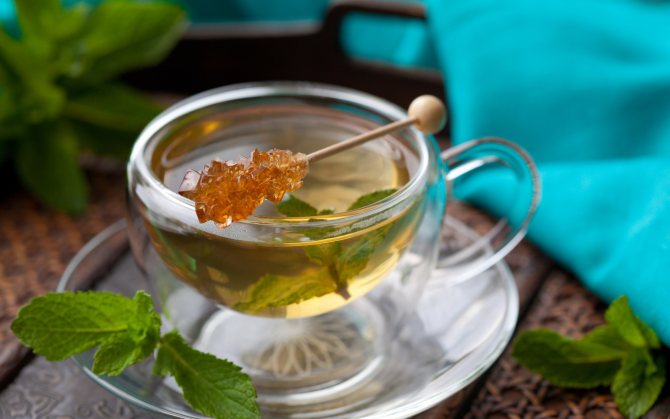
In order to go to the bathhouse with a cough, you should also consider the following precautions:
- Before visiting the steam room, you should give your body time to gradually adapt. To do this, you can stay in the so-called dressing room for some time, and then go to the steam room for a short period of time. The time spent in the steam room should be increased gradually.
- If your health worsens at the time of visiting the steam room, you should immediately finish the bath procedures.
- You should not combine visiting the steam room with drinking alcoholic beverages. It is necessary to understand that alcoholic drinks, combined with increased temperature and humidity, can even lead to death, as they negatively affect the cardiovascular system. They will not help with diseases of the ENT organs and respiratory tract. It is necessary to carry out the necessary antiseptic treatment of the throat using medicinal herbs or prescribed medications.
- It is not recommended for a coughing person to wash in a bathhouse with alternating cold and hot water. Only warm water is acceptable for washing.
- When coughing, it is strictly prohibited to use hardening procedures when leaving the bathhouse outside (for example, swimming in an ice hole). The weakened immunity of the body in this case is not ready for such shocks.
- To avoid the appearance of new or intensification of existing signs of the disease, it is unacceptable to leave the bathhouse with wet hair and body. At the end of the bath procedures, you should dry yourself and dress warmly. For the same reason, it is not recommended to stay outside for a long time after a bath. You must immediately move to a warm room.
A good recommendation is to drink a herbal decoction after a bath, tea with honey, lemon or ginger, or milk with the same honey or butter after visiting a bath. The choice of drink ingredients directly depends on the nature of the cough (wet or dry) and accompanying symptoms.

Failure to follow recommendations for visiting a bathhouse when coughing and ignoring contraindications leads to complications of chronic and acute diseases of various origins. When used correctly, bath procedures have a healing effect on the entire body, as well as on problems localized in the respiratory tract and ENT organs.
Why you can’t heat boils
Heat relieves pain and spasms, dilates blood vessels, improves blood flow to organs and tissues. Heating pads and taking a warm bath help with back pain, and the steam room helps with respiratory diseases. But heating boils is dangerous.
Heating will improve blood circulation in the area of inflammation, its symptoms will become more pronounced, and the outbreak will spread to healthy areas. High temperature can contribute to the opening of the abscess and blood poisoning.
It is not recommended to use a blue lamp for boils. This is an excellent and time-tested remedy for treating respiratory diseases, but it is not suitable for furunculosis.
When consulting a doctor, you should ask whether it is possible to wet the boil. Hygiene of the inflammation site is important. If the boil is not yet ripe, then it can be wetted with lukewarm water and gently washed with soap. Opened boils should not be wetted; a new infection may be introduced.
Traditional methods of treating boils
Traditional medicine has in its arsenal many means that help in the fight against boils. They should be used with caution and after consultation with a doctor.
The most popular and effective folk remedies for boils
Brewer's yeast
Sold in pharmacies, used strictly according to instructions. Helps improve metabolism and body resistance.
Pure yellow sulfur
Can be bought at a pharmacy. Take orally at the tip of a knife for several days in a row. Sulfur helps cleanse the blood.
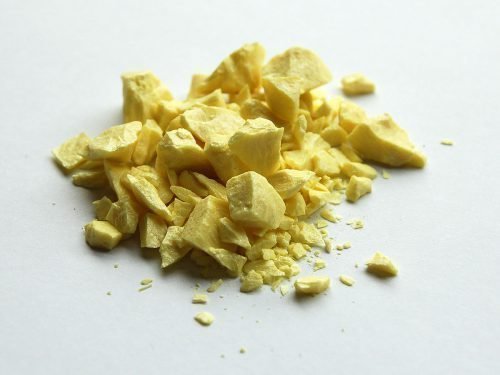
Pure yellow sulfur is applied internally
Plantain leaves
The plant can only be collected in a clean place, away from the road and enterprises. Wash the plantain leaf well, mash it in your hand and apply it to the boil.
Cut a leaf from the plant, wash it, and cut it with a clean knife. Apply the pulp of the leaf to the boil and wrap it for several hours.
Calendula tincture or tea
Taken orally to enhance the immune system. Calendula lotions help relieve symptoms of inflammation and speed up the process of boil ripening.
Honey cakes
They are made from rye flour, honey and milk. Apply to boils to speed up ripening.
All folk remedies are available to everyone. You can use them for boils after consulting a doctor. If allergy symptoms appear after using the product, you should stop treatment immediately.
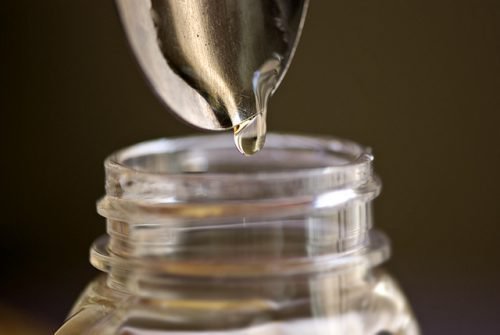
You can make a boil cake from honey and flour
Ointments for the treatment of boils
To treat furunculosis, antibiotics and local agents in the form of ointments are used. They help reduce the focus of inflammation, reduce the pain of symptoms, accelerate the maturation of ulcers and facilitate wound healing after opening.
There are three types of ointments for treating boils:
- antibacterial;
- pulling;
- healing.
Antibiotic ointments are used to treat boils on the face, ears or nose. They kill bacteria and cleanse the inflammatory focus from pus. The most popular and accessible remedies are Levomekol, Tetracycline and Oflocaine.
Pulling ointments are used in the early stages of inflammation. They stimulate the formation of the head of the boil - pustule. The abscess opens faster. Do not squeeze out pus with your fingers. The most commonly used are Ichthyol ointment, Heparin and Syntomycin.
Healing agents are used at the end of treatment to restore the integrity of tissues and metabolic processes in them. The most popular remedies are Vishnevsky ointment and zinc ointment.
Vishenevsky ointment is a universal remedy. It has antibacterial, anti-inflammatory and healing properties, softens the walls of the abscess after opening and stimulates skin healing without the formation of compactions.
Any ointments can be used only after consultation with a doctor and in combination with immunostimulating agents.
Uncontrolled treatment of boils and improper behavior can lead to serious consequences. The danger of diseases cannot be downplayed. Only professional medical help can get rid of boils forever.
Also useful for repairs:
- Automatic lighting effects on k155ir13
- What does insufficient ventilation of the room lead to?
- How to bleach white fabric at home
How to treat boils. Face and body care
First you need to find out what exactly you are faced with. A boil, or boil as it is also called, is a cavity in the skin filled with pus.
In medical terms, it is an inflammation of the hair follicle and sebaceous gland, as well as the surrounding connective tissue. Certain pyogenic bacteria, which include Staphylococcus aureus, contribute to the formation of a boil.
Their size can vary from 1-2 mm to 5 cm or more.
A boil can appear in absolutely any part of the human body, but this disease has its own favorite places. So, in most cases they occur on the neck or armpits.
In addition, boils can be found on the face, buttocks, chest or groin.
Particularly large abscesses, or several abscesses located nearby, are called carbuncles. Typically, such formations are deeper than ordinary boils, so they can cause more severe pain.
Furunculosis is a constant eruption of boils on different parts of the body and at different stages of development of this problem. This disease can appear in every person.
In addition, localized furunculosis is also encountered in medical practice, when an unlimited number of ulcers appear on a small area of skin. You need to know that you will not be able to cure such abscesses without the help of others.
Doctors also distinguish between acute and acquired types of furunculosis. With acute furunculosis, a huge number of ulcers form immediately or over a short period of time. In turn, acquired furunculosis lasts for quite a long time, during which abscesses appear alternately or in separate outbreaks.
If you find such a formation on the skin, you should immediately contact the clinic. An experienced doctor will tell you how to cure a boil just in your personal case.
Causes of boils
In most cases, the occurrence of ulcers occurs due to the fact that various bacteria enter the hair follicle. Unfortunately, this is not the only reason. The formation of boils is also facilitated by microtraumas of the skin, excessive sweating, frequent contamination of the skin, and increased secretion of subcutaneous sebum. Also, the appearance of boils is caused by metabolic disorders, bad food with a huge amount of dyes, and also a decrease in immunity.
The appearance of a boil never goes away without any traces, because it always comes along with painful feelings. From time to time, some swelling or itching may appear on the skin.
What to do if a boil appears in the ear?
The appearance of boils is unsafe on any part of the body, but still, abscesses that appear in the head area are much more insidious. So, the real test will be a boil that appears inside the auricle. In addition to the usual symptoms of a boil, you may experience tinnitus for some time, and hearing impairment or temporary hearing loss is also possible. Painful sensations may appear when moving the lower jaw. How to cure a boil in the ear so as not to experience pain when chewing and discussing?
If you feel something is wrong, you need to go to the clinic as soon as possible. Treatment at home can be very unsafe and cause unpleasant consequences. An experienced doctor will give you a hint on how to relieve pain and get rid of a boil using the most reliable and harmless method. You should not try to cure a boil inside the ear without the help of others; it is best to do this under the supervision of doctors.
If a boil has formed in the armpit
When a boil occurs under the armpit, the skin there noticeably swells, redness occurs, and it becomes painful to move your hand. The formation of an abscess in this place could be caused by excessive sweat production, frequent and long stay in the heat, as well as neglect of personal hygiene. If a boil appears under the arm, how can you cure it at home?
It is not recommended to remove such formations at home.
Therefore, you will only cure the visible problem. In order to get rid of a boil once and for all, it is necessary to understand the cause of its occurrence. As soon as you find a boil, treatment should be immediate. First, the doctor will determine the reasons why the boil appeared. If during the examination it turns out that the boil is caused by a bacterial carrier, you may be prescribed the use of bactericidal ointments, as well as internal medications. If the cause of the ulcers is something else, the doctor will begin to adjust your diet, removing sweets, including sugar, refined and very fatty foods.
The problem of boils in diabetic patients
Unfortunately, today the number of people suffering from diabetes is very large. This disease is very common among people of all ages. People with diabetes are more susceptible to various diseases. The most common troubles with diabetes are purulent diseases. Boils in diabetes occur even more often than in healthy people. Why is this happening?
This is because people with diabetes have a very reduced resistance to various infections. A lack of insulin causes the entire body to malfunction.
That is why under no circumstances is it advisable to self-medicate. If you find a boil in yourself, you should consult an endocrinologist as soon as possible. Only he can correctly diagnose your illness. It very often happens that one small boil over time turns into a carbuncle, or, even worse, furunculosis.
Treatment of boils or furunculosis in people suffering from diabetes should be carried out in a comprehensive manner. First, it is necessary to normalize the amount of insulin in the body, after which it is necessary to achieve a decrease in glycemic levels.
What can be done to make the boil ripen faster?
The formation of a boil is a rather long and painful process. The head appears only on the 3rd day, and all these three days you will experience aching pain in the affected area. Is it possible to change this somehow? Is it possible to do something to make the boil ripen faster?
Yes, you can use very good traditional means for this.
- The red leaf must be cut in half and fixed on the boil. The red plant has special qualities that can stretch the pus outward, thereby accelerating the formation of boils. In addition, red also promotes rapid healing of the skin after the boil breaks out.
- When a boil forms, how can you cure it if you don’t have a red one? There is another reliable remedy that helps get rid of ulcers no worse than red. This is a soapy onion paste. A small onion must be baked in the oven, then passed through a meat grinder, and laundry soap should be rubbed into the resulting mixture. The recipe is as simple as two times two. The resulting mixture must be mixed well and applied to the boil as a compress. The dressing can be changed twice a day.
Is it possible to wet a boil and go to the bathhouse with it?
There is a lot of controversy on this matter. Doctors relentlessly advise not to wet the boil. When using dressings, do not bathe in the shower or bath, as this can only harm the healing. Also, doctors warn and dissuade patients from going to the bathhouse, they say, a boil and a bathhouse are two incomparable things.
It is recommended to go to the bathhouse only if there is an acquired form of furunculosis, and only if its form is not inflammatory-purulent.
In turn, people who self-medicated strongly advise visiting the bathhouse, because, according to them, purulent formations disappear the very next day after evaporation.
It’s up to you, of course, to decide who to believe and what methods to adhere to, but before you start self-medicating again, think carefully and evaluate your strength.
When does surgery occur?
Surgical treatment of boils occurs very rarely. It occurs in cases where standard treatment does not bring any results, when an abscess appears, or other complications.
The opening of the boil is carried out under local anesthesia; from time to time, if the case is very complicated or advanced, general anesthesia is used. An incision is made above the boil, through which the entire purulent mass is removed along with the rod. The wound is treated with special means, cleaned and a bandage is applied to it. After such operations, the pain disappears instantly, and the recurrence of the boil is unlikely.
Blood purification
You need to know that the most unsafe place for boils to occur is the nasolabial triangle. If you do not promptly treat the abscess that appears in this place, pus can get not only into the inner layers of the skin, but also cause blood infection, which very often leads to a fatal ending. Purification of blood from boils is not always prescribed, but if you are still prescribed such a function, it means you have serious difficulties.
Blood purification during a boil is carried out in a variety of ways. All products created for internal healing are used to cleanse the body of staphylococcal germs.
www.norfa.biz
